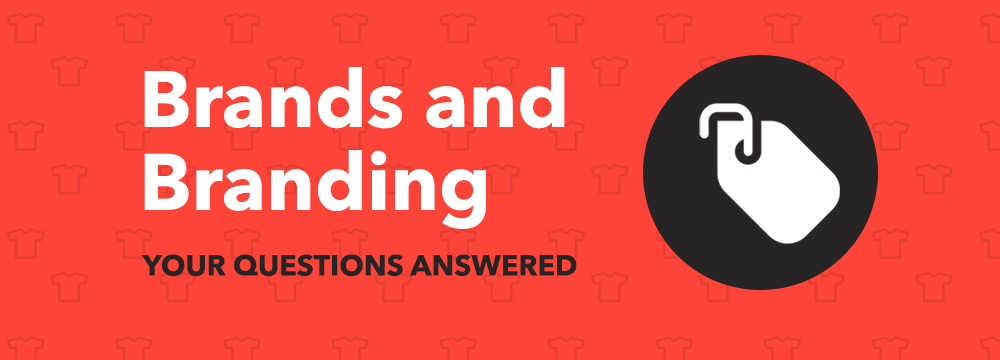
Brands and Branding while Selling T-Shirts Online: Your Questions Answered
by Michael Essek · Updated: January 31, 2022When it comes to selling T-Shirt online, branding is one of the things you’ll wrestle with sooner or later.
- Should you have one T-Shirt ‘brand’ for all your designs – or several?
- Should you keep your brand identity specific to a single niche, or broad and general to appeal to as many people as possible?
- Should you brand yourself as an individual artist / designer, or as a business / company?
These are questions I get asked a lot, so I thought I’d delve into some of the various considerations here…
(and that way I don’t have to personally reply to a bunch of emails individually in the future – I can just send people this link 🙂 )
Let’s Clarify Terms
‘Brand’ is a broad and nebulous term – it can mean different things to different people – so let’s try to clarify what we mean here.
Whenever you engage in any kind of selling or marketing online (or in person) – you are inevitably involved in ‘branding‘, whether you know it or not.
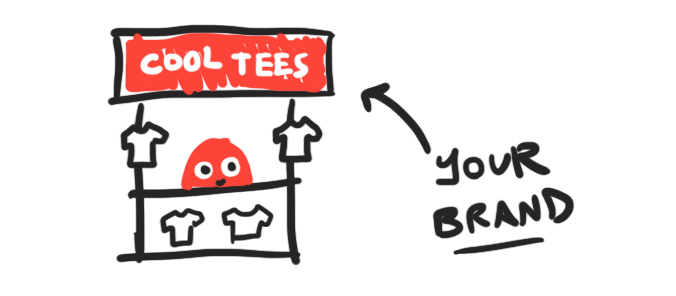
From the public username and avatar you use, to the way you describe your designs (and the way you present your products) – all of this is branding.
The degree to which this branding makes any difference to your sales depends on the sites you are selling on (and the way you expect customers to find and purchase your designs).
So for the sake of clarity, for the remainder of this article I will use the term ‘brand’ to mean the headline entity under which you sell or present designs and products to your potential customers. So this could be the your Redbubble account, or your own Shopify store.
That ‘brand’ might be presented as an individual (eg. ‘Michael Essek – Designer and Illustrator‘) or as a business (eg. ‘Essek Clothing‘) – but both these examples would still be ‘brands’.
Does Branding Matter?
When it comes to selling Shirts online, the answer is yes and no.
For some print-on-demand sites (like Merch By Amazon) the public brand under which you sell probably matters very little – at least when it comes to actually making sales in the here and now. (more on the specifics of brands within Merch By Amazon later).
So if you’re only interested in makes sales on POD platforms, and have no intention of starting your own website (or selling via a platform like Etsy) – the brand you sell under is probably not going to make a huge difference to your actual sales.
It also depends on the way in which you expect to make sales.
Eg. – for the vast majority of my Merch By Amazon sales, it isn’t the brand that the customer is searching for, but the design.
Customers arrive at designs through search (via google, or directly on the site) – and then they purchase – because the design matches what they were looking for.
Where branding may start to matter a little more is when a customer sees something they like, and then want to ‘check out’ the source of the product, to see what else this ‘brand’ (or person) has to offer (eg. by clicking on the brand or designer link – see images below).

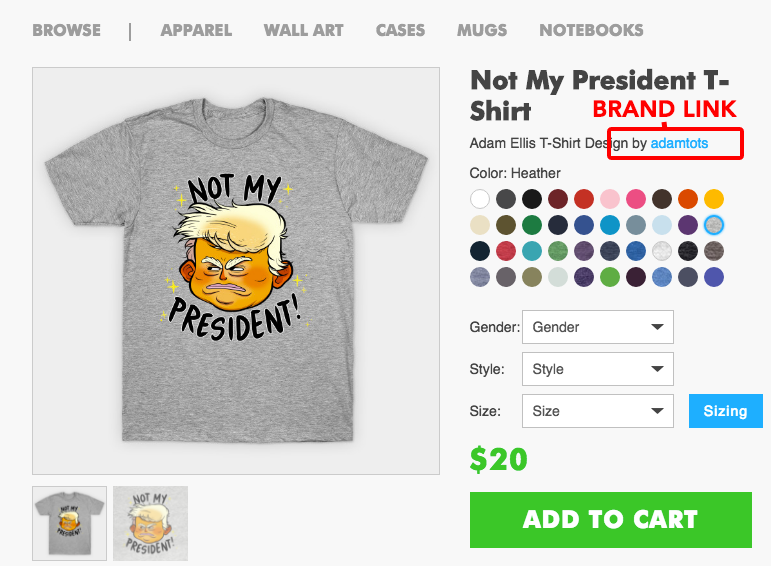
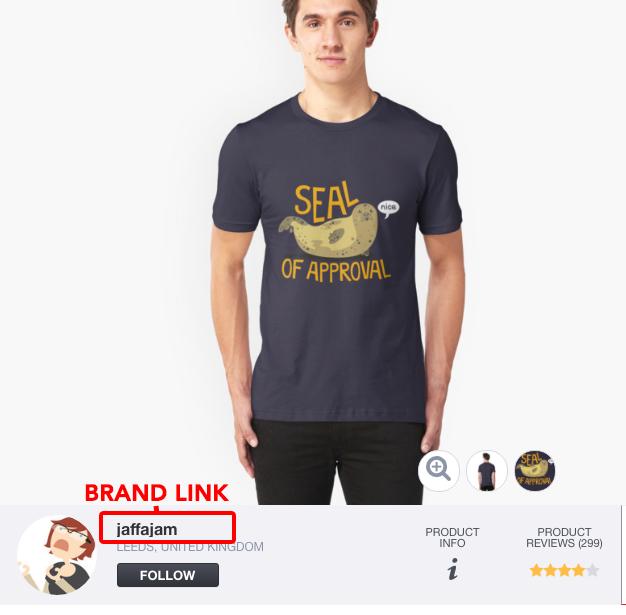
Teepublic and Redbubble also display other designs from your brand store beneath products – see examples below:

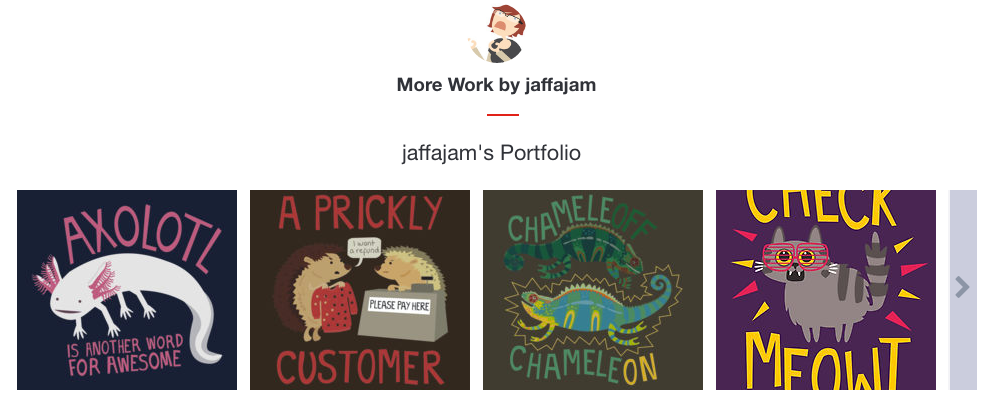
Is this a big driver of sales on POD sites, or on Merch By Amazon? I don’t really know, and I don’t have any easy way of finding out. I can tell you that I personally often check out the source of designs or products when shopping online, but maybe I’m not representative of the general buying public.
But this tendency (of wanting to check out what else someone has to offer) is going to be a lot more prevalent and important on sites like Etsy, or on your own website – and, for example, in a situation where a design or product of yours goes ‘viral’ (eg. “Hey that’s funny, let my check that person out and maybe follow them“).
SO…
If you are taking a long term view, and want to grow a secure, sustainable business that connects directly with customers (rather than simply developing an income from royalties by licensing designs to others) – then your branding really is going to matter.
Clear so far?
Then let’s answer some questions:
Q: I have a lot of different T-Shirt Designs appealing to different niches. Should I set up a new brand/account for each niche on every POD site I sell on?
This is a good question.
I think the answer depends on:
a) Your goals (short and long term)
and
b) The nature of your designs
so let’s start with your goals.
If your goal is to simply make some cash from POD sites with as minimal effort as possible (nothing to be ashamed of btw) – then I wouldn’t see any need to split your designs across multiple accounts.
This is because the primary driver of your traffic and sales is likely to be organic search (assuming you aren’t going to do any free or paid advertising of your own) – and in such cases the brand simply doesn’t really matter. The customer is going to buy based on the design, and they’re going to give little to no thought to the associated ‘brand’ or designer. (They are much more likely to consider the banner ‘brand’ or site from which they are purchasing – eg. Amazon, Redbubble, Teepublic etc.).
IF however you want to eventually set up your ‘own brand’ store (eg. a Shopify or Woocommerce powered e-commerce store, or even an Etsy shop) – then it would probably make sense to keep the designs you intend to use for that store separate from the others, in a standalone account.
For example – let’s say you have a lot of different designs appealing to different niches, within which you have several designs targeting Vegans.
You intend to setup your own Vegan brand in the future, and sell these designs in that store.
But you also want to make money from these designs through POD sites in the meantime.
In this case I would want these designs to exist under their own brand / account name on each POD site I sell on – separate from any non-Vegan related designs. (And ideally this will be the same brand name I eventually use for my own Vegan brand).
That way my designs are associated with a relevant brand name and they make sense as a collection to potential customers – and I may begin to develop some ‘brand equity’ – even before I ever launch my own store.
Furthermore it could be weird, confusing or straight up embarrassing for customers to see my Vegan designs appearing alongside my ‘Meat Lovers’ designs – especially if both are under the same account or artist brand. It could also serve to de-value your designs in the eyes of your potential customers – ie. “I thought this guy was a real cool Vegan designer – turns out he just designs random t-shirts. I thought I had found a cool Vegan-friendly artist or brand I could support and connect with, but now I see all these other designs I’m just not feeling it.”
So now let’s consider the nature of your designs.
If your designs are all ‘Trust Me I’m An Engineer’ (replace engineer with every conceivable occupation, x1000) boiler-plate type stuff, then it really doesn’t matter a lick that they all exist under one account. You aren’t trying to appeal or strike up an ongoing relationship with a customer, you just want to make the sale. And of course it would be quite arduous to setup a different account for every occupation.
But let’s say you do some real ‘high end’ designs: detailed artistic, illustrative work that takes you hours to complete.
Does it make sense to sell these right alongside a simple pop-culture, text-only design?
Probably not. You would probably be much better off setting up a separate account for your simple text-only designs, and attempting to really develop a ‘brand’ around your high-end stuff (which would better lend itself to being sold on your own site at some point in the future). That way customers get a consistent message and vibe when they see your work, and hopefully they will think of you as ‘the guy who does those really cool illustrative designs’ instead of ‘the guy who does a whole bunch of stuff’.
Q: Should I present myself as an individual artist, or as a ‘brand’ / company?
This is a hard question to answer, because there are so many elements to consider.
Generally speaking, businesses and companies who sell directly to customers tend to ‘own’ the platform through which they sell (Eg. ‘mybrand.com’).
Artists on the other hand are much more likely to make products available via a third-party – whether that be a print-on-demand site like Redbubble, a Shirt-A-Day site like TeeFury, or a marketplace like Etsy.
If you want to submit to sites like TeeFury, the assumption is that you will be an independent designer – not a business. After all, why would a business – eg. Johnny Cupcakes – sell a design on a site like TeeFury? The whole identity and marketing message of TeeFury (and of Ript, and Teepublic, and Redbubble etc.) is that they are a place to support independent talented designers.
Further considerations…
Businesses – especially when they sell directly to customers – have to deal with customer questions, complaints, returns and so on. Whereas an independent designer selling on Redbubble will have no such concerns.
As an independent artist you may feel a bit more freedom to create different kinds of designs and to focus on different niches – whereas a brand or business will usually attempt to ‘niche down’ to appeal a particular group or demographic, and to stay in that groove for a long time to develop brand equity.
But perhaps the biggest consideration is that of scaling up.
Independent artists can usually only scale up so far in a financial sense (there are exceptions of course) – because they are expected to produce every piece of work themselves, and often to manage a lot of the other parts of the operation themselves (research, responding to fans, doing commissions etc).
T-Shirt or clothing brands on the other hand can scale up to almost any size, because the designs aren’t tied to a single designer, and because there exists brand equity apart from the individual producing the work.
Now – some questions for you…
Would you ever want to sell your T-Shirt brand and go do something else? If so, you would probably want to set out with that goal in mind, and start building your brand as a ‘business’ from the start.
Are you comfortable being the face and identity of a brand, and have no intention of growing a big T-Shirt biz? Then presenting yourself as an individual artist is likely to be best.
These are really just some things for you to consider – there are of course examples of individual artists who have grown into huge brands (eg. Paul Frank), and of course there are a lot of ‘non-personal’ brands selling through POD sites or Etsy and doing very well.
The main thing is to figure out which is right for you, based on where you see this thing going.
Q: What about brands within Merch By Amazon?
When we talk about ‘brands’ on Merch By Amazon, all we’re really talking about is the text you enter in the ‘brand’ field on any given design.
This can be different for every individual design, if you want it to be.
To further complicate matters, Merch By Amazon doesn’t make these brands unique or exclusive to each seller – so anybody can list their designs under another’s brand, should they wish to.
Oh and brand names do seem to contribute to Amazon’s search algorithm – meaning it can be helpful to have some relevant keywords included in your brand (which will of course usually be different for every design).
Finally there is the issue of rampant copycatting and undercutting on Merch – which has led many sellers to create as many ‘brands’ as possible, in order to keep a copycat from easily viewing all (or many) of your Shirts, so that they may easily steal/copy your bestsellers.
So (phew), how should you use the brand field within Merch?
I originally listed everything under one brand, but then got hit so hard by copycats that I started doing everything under a separate brand.
However, I am now beginning to come back full circle, because:
- copycats can find Shirts that sell well in many ways – so having separate brands doesn’t really protect against copycats
- I think there is something to be said for brand recognition and associated sales through the brand link – especially if you have a lot of similar, connected, relevant designs. I don’t have any hard data on this, but I’m beginning to think that you are probably missing a trick by not exposing customers to your brand (even if it’s just the name alone) – especially if you do sell on your own or other sites, given the volume of traffic that Amazon attracts.
- Amazon seems to be making moves towards a ‘brand-friendly’ approach, in much the same way that Google did a few years ago. This means Amazon likes and prefers products from meaningful, ‘real’ brands – as opposed to standalone products sold from faceless entities. So I think those accounts that can demonstrate the existence of a true ‘brand’ (eg. own website, social media, existing fan base) will be those who get a thumbs up from Amazon, and perhaps will have an advantage over others in future.
Anyway, that’s where I’m at now, and where I see things going.
My advice would be to gather your designs into a handful of ‘brands’ – and then spin those off into their own websites etc. if appropriate.
Amazon does of course reserve the right to alter brand names whenever they like anyway – so perhaps we will see some kind of enforced brand changes in the future.
Okay, that was one crazy blog post – if you read it all then you deserve some kind of prize.
I hope you got some clarity on the brand situation in amongst all that.
If you have further comments or questions – I’d be happy to hear them below!
Supercharge Your T-Shirt Sales With My Top Strategies, Tips & Tricks

The best way to improve your T-Shirt sales is to improve your T-Shirt design IDEAS.
In my free eBook 'The Idea Files' I show you how to improve your Idea ability, and profit from trends using exclusive techniques and strategies you won't find anywhere else!
Get it free, here:




